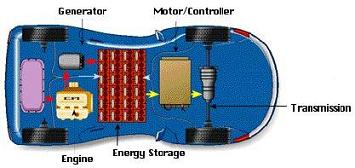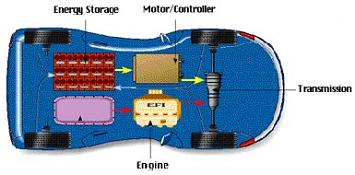Hybrids: A Step in the Right Direction
|
A hybrid vehicle is a vehicle that runs using the usual gas-fueled engine as well as an electric battery to store extra energy. The best thing about the hybrid car is that, unlike electric cars, you donít have to plug them in to use the battery! This is because the battery is able to charge up while the vehicle is being driven. The efficiency of a typical hybrid vehicle cuts emissions by 25% to 30% compared to even the most efficient gas-powered vehicles [1]. |
|
Types of Hybrid VehiclesThere are two main types of hybrid vehicles: the series (or "mild") hybrid vehicle and the parallel (or "full") hybrid vehicle [2]. (The mild/full terminology is usually used by salespeople and marketing agencies, whereas scientists tend to use the series/parallel terminology. Since this is a science-related webpage, we will stick with the series/parallel terminology from here on in.) As you may imagine, these names have much to do with the way in which the electric motor and the engine interact to power the vehicle. The Series Hybrid Vehicle connects the gas-fueled engine to the battery by means of a generator, which converts the mechanical energy produced by the engine into electrical energy that is stored in the battery. The battery, in turn, powers the electric motor that moves the vehicles. Thus, the engine itself has no direct connection to the transmission and does not contribute directly to turning the wheel axle [3]. This system is analogous to an electrical circuit hooked up in series, in the sense that the motors (resistors) are strung together one after another and that only one motor (resistor) is connected to the transmission (power source). For a visual representation, see the diagram below (diagram courtesy of the U.S. Department of Energy Clean Cities Program): |
|
|
|
|
|
The Parallel Hybrid Vehicle allows for both the engine and the electric motor to be independently connected to the transmission. This means that, at any given time, either of the two motors can be used to propel the vehicle. This setup has the advantage of being able to provide more power, or acceleration, to the vehicle since the engine is directly connected to the transmission [3]. This system is analogous to an electrical circuit hooked up in parallel, in the sense that the motors (resistors) are each independently hooked up to the transmission (power source). For a visual representation, see the diagram below (diagram courtesy of the U.S. Department of Energy Clean Cities Program): |
|
|
|
|
Now that we've seen the main types of hybrid vehicles, let's go and take a look at the inner workings of a hybrid vehicle. Click here to find out what's under the hood!
 In this section, we will give a brief introduction to some of the concepts related to hybrids by discussing the two main types of hybrid vehicles: the series and parallel hybrid vehicle.
In this section, we will give a brief introduction to some of the concepts related to hybrids by discussing the two main types of hybrid vehicles: the series and parallel hybrid vehicle.
